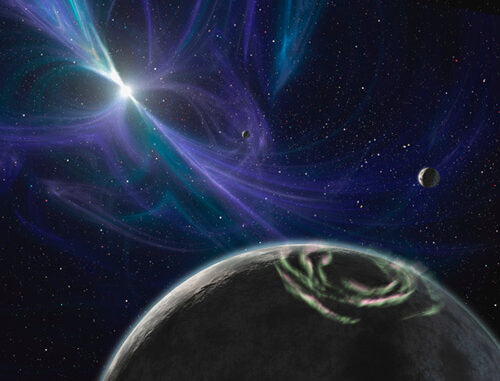

StockTrek/Getty Images
Artist’s concept depicting the pulsar planet system discovered by Aleksander Wolszczan in 1992 using the Arecibo radio telescope
Have you ever seen the James Bond movie GoldenEye or either of the science-fiction movies Contact or Survivor? Have you watched the Little Green Men episode from the classic television show The X-Files? If so, you know how massive the Arecibo Observatory is!
Where would you have to travel to find the world’s largest radio telescope? West Virginia? Russia? Germany? England? Australia? All of these places do have radio telescopes, and there are many more all over the world. However, you would have to travel to a valley about ten miles south of Arecibo, on the northwest coast of Puerto Rico, to see the planet’s largest single-dish radio telescope—1,000 feet in diameter (about three football fields)! The Arecibo Observatory, part of the National Astronomy and Ionosphere Center (NAIC), is operated by SRI International, under a cooperative agreement with the National Science Foundation and in alliance with Ana G. Méndez Universidad Metropolitana de Puerto Rico and the Universities Space Research Association. The National Aeronautics and Space Administration (NASA) also provides additional support.
Completed in 1963, the Arecibo Observatory studies the shape and formation of the galaxies by deciphering radio waves from space. It precisely and clearly detects asteroids or comets that could hit Earth. Since one theory holds that the dinosaurs were wiped out by a massive asteroid hitting Earth, detecting potential impact early seems to be quite important! The telescope not only detects these near-earth objects (NEOs), it also has unsurpassed capabilities for taking clear, precise photos of them. The Arecibo telescope is responsible for many significant discoveries and accomplishments. It detected the first planets outside our solar system, as well as thousands of new galaxies. It discovered the first pulsar (rapidly rotating neutron star—the collapsed core of an exploded massive star) in a binary system, confirming Einstein’s theory of relativity and earning the astrophysicists a Nobel Prize. The telescope established a rotating rate for Mercury and investigated the ice craters at its polar regions. It detailed maps of the distribution of galaxies in the universe, tracked celestial objects in different regions of the sky, and imaged the surface of Venus.
The telescope is also suited to search for and communicate with extraterrestrial life. Fortunately, or unfortunately, depending on your point of view, no extraterrestrial signals have yet been detected!
Explore More:
1. Investigate additional significant discoveries and accomplishments of the Arecibo Observatory. You may want to check Web sites such as NASA or NAIC. Choose one topic that interests you and give a report to the class.
2. Research to determine what factors make the valley outside Arecibo such a perfect place for a large radio telescope.
3. If you are interested in science, learn more about the actual telescope itself—design, structure, various components, size, and weight. Explore the definition of a radio telescope and how it functions.
Share What You Know:
1. Debate whether the Arecibo Observatory will one day receive signals indicating the existence of extraterrestrial life and what that might mean for our planet.
2. If you have studied radio waves in science class, discuss what you have learned and how they relate to radio telescopes.
3. The United States has many radio telescopes. Is there one in your area? Have you ever visited it? If so, tell what it was like and, if not, you might want to arrange a visit.
4. Besides movies and television shows, several novels have been set at this location, and there are also songs that mention the observatory. Watch one of the movies mentioned in the article, or find and read one of the novels, and report back to the class about how the Arecibo Observatory was depicted and what you learned about it.